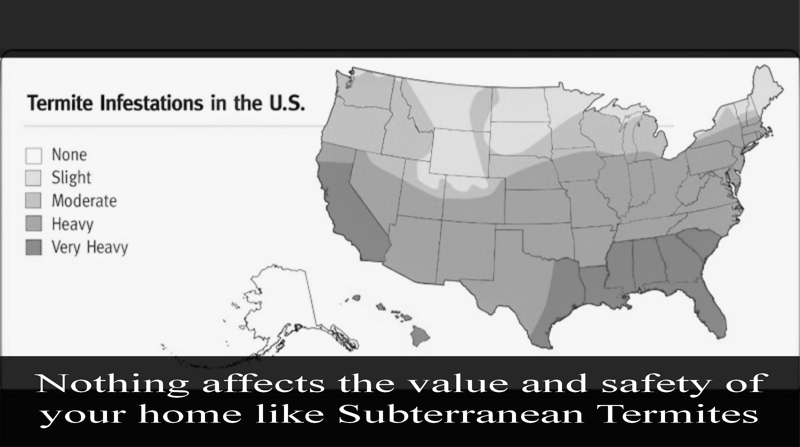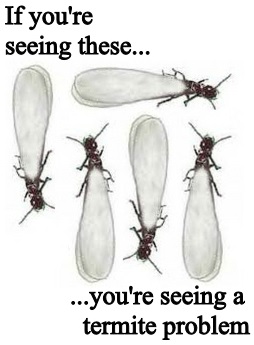 |
|
|
FREE CONSULTATIONS
PEST CONTROL
SPECIAL SERVICES
WDO REPORTS
TERMITES |

|
 |
SELECT A PEST FOR
SERVICE DETAILS
|

ROACHES | 
ANTS |

SPIDERS | 
TICKS |

RODENTS | 
TERMITES |

MOSQUITOES | 
BED BUGS |
Termite Information EVERYONE
REALLY needs to KNOW
-
Subterranean Termites ARE NOT covered by your Homeowners insurance policy because they have been labeled as “too common"--and “too expensive” per singular infestation
Subterranean Termites account for more property damage every year than storms, hurricanes, fires, floods and tornados combined
-
There are NO methods of home construction that are safe from Subterranean Termites. Not concrete block. Not steel. None
-
Similarly, there are NO kinds of wood that are safe from Subterranean Termites. Not cypress. Not railroad ties. Not telephone or power poles. Not pressure treated.
-
Subterranean Termites are everywhere in the ground in Florida to a point where every square foot of the state is completely infested. Conservative estimates indicate that there’s about 43 million active termites for every ONE person in Florida at any given time
-
More than 600,000 completely different homes have more than $8,300 worth of Subterranean Termite damage done to them each year--right under their owner’s noses
-
Modern or not, every structure that is meant to be lived in is full of wood and cellulose product that Subterranean Termites live to destroy: From roof, drywall, floor and counter supports to kitchen cabinets, wood floors, baseboards, door frames, window sills, insulation, electric cables, a/c handlers, bath-traps, drains, furniture, carpet glue, pool liners and almost everything in between. Including, obviously, cardboard, storage boxes, pictures, paintings, frames and paper products of every type
-
Subterranean Termites thrive in wooded areas, and are able to cause more damage--that much faster-- the closer they are to lakes, swimming pools and large bodies of water
-
Adam Hughes Putnam, The Florida Department of Agriculture’s Commissioner, says: “It is not a question of if you will get termites, it is a matter of when. Most homeowners believe that if their property has been treated once for subterranean termites, their worries are over and they will never have termites. Unfortunately, whether your home is new or old, this belief is not correct. Proper treatment is vital, but Annual Inspections are every bit as critical”
-
Due to our climate, lack of a true winter and year-round humidity, there are more active kinds and varieties of Subterranean Termites in Central Florida than there are anywhere else on the planet
-
Having mulch, tree stumps, wood chips, land timbers, decks, firewood or any other kind of wood, or wood product, in contact with the ground around your home is asking for problems because the true, natural purpose of Subterranean Termites is to eat dead wood
Frequently Asked Questions
How can I tell the difference between flying ants and termites?
Termites are often confused with ants; however, a few simple things distinguish the two. Termites have straight antennae; a broad waist; short legs; and both wings are the same size with a kind of wax-ish appearance. Ants have elbowed antennae, a much smaller waist, and wings at different lengths
If my swarmers are gone, I don’t really have termites, right?
Swarmers don’t leave, they only burrow into places out of site to start a colony. More often than not, though, seeing swarmers at all usually indicates that termites have been infested your home (or an area VERY close to it) for at least a couple years. When you consider that the only function of any swarmer is to establish a new colony, it’s easy to see how each one can combine to increase the destructive damage termites can inflict on your home. If you see swarmers, or think you have, call a professional at McKenzie Pest Management right now.
Could the way my home is built make it more susceptible to termites?
Yes. If you have a hollow block wall it creates an entry-point for Subterranean Termites. If you have stucco construction, and it is in contact with the soil around your home – that will also create an entry-point for Subterranean Termites. If your home rests on a slab or you have an attached slab, such as a garage, and the slab contains settling cracks Subterranean Termites can come in that way, too. If your home is made of wood or there are wood structures attached to the home, such as a deck, porch or steps and the wood is not treated, termites have a direct conduit to your home’s structure. Ditto for crawl spaces and mobile homes. During Annual Inspections, our experienced technicians will pay particular attention to areas of your home that require closer assessments and will highlight this information on your Inspection Report.
Is there anything that I can do myself that will help?
So long as you understand that Subterranean Termites are everywhere in the ground in Florida and that nothing is going to replace a proper termite treatment, yes: There’s a lot you can do to minimize the speed of their damage
- Because Subterranean Termites are attracted to moisture, avoid accumulations of water near your home’s foundation. Use downspouts, gutters and splash blocks to force water away from your exterior walls
- Quickly repair roof leaks or plumbing leaks as well was any interior damage caused by excessive moisture
- Prevent shrubs, flowers, ornamental plants, vines and other vegetation from over growing on the exterior walls of your home. Also be sure to reduce humidity in crawl spaces by adding more vents
- Eliminate every piece of wood that’s in contact with the ground around your home
|

|
|
© McKenzie Pest Management, Inc. |
|